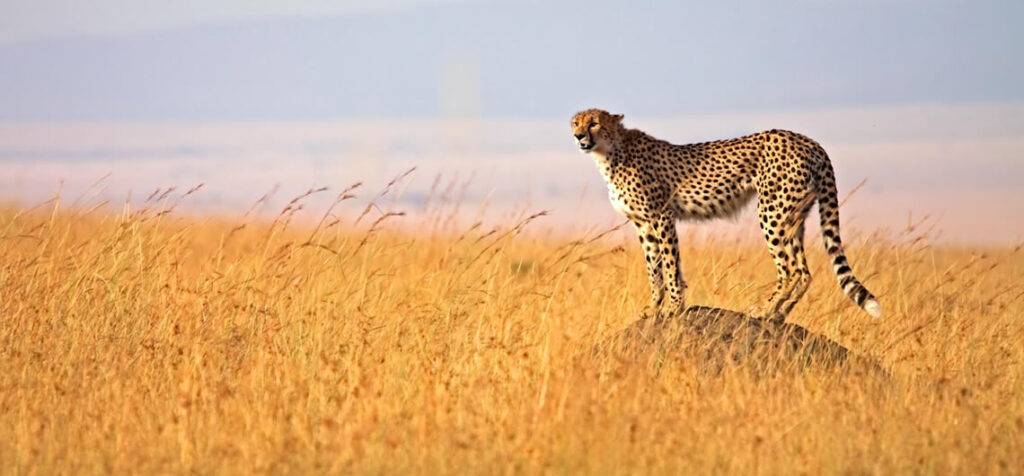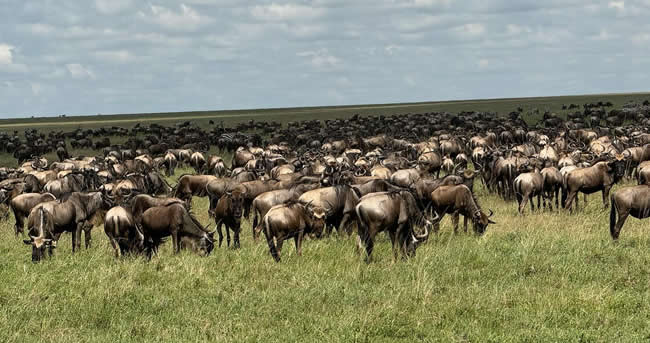Masai Mara National Reserve is one of the top visited tourism destinations in Kenya thanks to its natural endowments. Maasai Mara among the very few Africa’s richest ecosystems, home to all the Big 5 and the Great Migration. It is the best spot to witness the world’s highest concentration display of flowing wildlife comprising over 2 million wildebeest.
The Great Migration safari is one exceptional safari that guarantees you that close encounter with explosion of this world’s spectacle. Masai Mara is also home to abundant predators including lions, leopards, jackals, cheetahs, hyenas and several other carnivores.
Location, formation & size
Maasai Mara is found in Southwestern Kenya. It was first formed as Wildlife Sanctuary in 1961 occupying the land area of 520 sq. km of the present Mara Triangle. Still in 1961, the Maasai Mara Reserve area coverage expanded to the Eastern part making it 1821 sq. km. Its status later changed to Game Reserve under the local community of Narok County Council management. In 1974, Masai Mara was designated National Reserve status. About 159 sq. km of the Mara Reserve was given back to the locals. In 1976, about 162 sq. km of the reserve’s land was deducted accounting to the current 1510 sq. km as of 1984.
The Masai Mara is lying in the breathtakingly extensive rolling savanna plains. This Game Reserve is situated at the border with the Serengeti National Park.
The main attractions in Masai Mara
Wildlife
Masai Mara National Reserve a naturally endowed wildlife conservation area, a good reason it is a preferred wildlife safari destination in East Africa. Maasai Mara shelters diversity of wildlife including zebras, giraffes, buffaloes, rhinos, cheetahs, lions, Nile crocodiles, leopards, and wildebeests. Other wildlife include topis, hippos, bat-eared fox, baboons, warthogs, Thompson’s gazelles, elands, and serval cats.

Bird species
Approximately 500 species of birds survive within the Masai Mara including raptor species and resident species. The checklist of bird species to identify on Masai Mara birding tour include rufous-bellied heron, Kori bustards, Sooty chat, African fin foot, Abdim’s storks, bateleur, Denham’s bustard, Ayres’s hawks-eagle, Jackson’s window bird, ostrich, cinnamon-breasted bunting, Hildebrandt’s starling, grey-crested helmet-shrike, giant kingfishers, rosy-throated long claw, purple grenadier, lazy cisticola, rufous bellied heron, saddle-billed stork, Schawlow’s turacos, ross’s turacos, and tabora cisticola.
Additional species of birds to find in the different habitats in the Masai Mara include trilling cisticola, Southern ground hornbill, yellow-mantled window bird, Usambiro barbet, woolly-necked stork, Temminck’s courser, and yellow throated sand grouse and Swahili sparrow.
Masai Mara also shelters birds such as the African grey hornbill, griffon vulture, white backed vultures, white-backed vulture, the lappet-faced vulture, white route robin chat, superb starlings, white-bellied cannery, red-billed buffalo weaver, and others.
Ol Kinyei Conservancy
Ol Kinyei is among a few distinct attractions in the Maasai Mara. This conservancy area lies along the border with the Greater Serengeti-Mara ecosystem. It is Masai Mara’s biggest conservation areas also naturally blessed with spectacular rolling kopjes and wildebeest.
The other popular conservancy area is the Mara Triangle and this is controlled by the Trans-Mara County Council. The Mara Triangle is 510 sq. km and is found close to Oloololo Escarpment.
The Great Migration
A vacation in the Masai Mara is complete when the Great Migration is included. This is once in a lifetime experience where visitors on Kenya safaris enjoy a close encounter of the world’s powerful wildebeest migration. During the annual Great Migration, millions of the wildebeest cross the Mara River from Tanzania’s Serengeti. The Great Migration often includes other grazers such as zebras, gazelles, topis and elands. This natural spectacle usually occurs from July to October.

The people and their unique cultures
Adjacent to the Masai Mara are the Maasai villages. After or before the Great Migration/Big game drive, a visit to the Maasai village is great opportunity to explore more about the unique culture, traditions and practices of locals.
Top Activities to do in Masai Mara
Game drive
A safari guided game drive in the Masai Mara Kenya is the perfect way to explore diversity of wildlife in the savanna grassland. The likely wildlife to encounter on the Maasai Mara game drive include lions, leopards, giraffes, elephants, zebras, wildebeest, elands, hyenas, and others.

Hot air balloon tours
The hot air balloon excursion offers the best aerial viewing experience. This is enjoyable in the morning or evening. You fly above the golden savannas of Masai Mara while you enjoy views of small and large mammals plus the breathtaking landscapes.

Birding/bird watching
Birding excursions in the Mara Reserve is a great deal to explore diversity of avifaunal species. Among the numerous species of birds to come across in this reserve include migratory birds which often confine in the habitats from November to April. The notable birds include the sooty chat, Kori bustard, Usambiro barbet, secretary bird, African fin foot, Abdim’s stork, ostriches, ross’s turacos, grey penduline tit, Bateleur, rosy-throated long claws, rufous-necked wryneck, Jackson’s widow bird, Giant kingfishers, cinnamon-breasted bunting, and more.
Guided bush walking
Masai Mara bush walking safaris usher you deep into the jungles to explore diversity of wildlife hard to be spotted during the game drive in a 4×4 safari vehicles. This is best done around Kicheche camps.
Best time to visit the Maasai Mara
July, August, September to October are the best dry months of the year to explore the Maasai Mara National Reserve. These are the peak months to enjoy the best of the Great Migration. They are also the most favorite months of the year to explore other wildlife, especially predators including lions, leopards, cheetahs and the Nile crocodiles as they hunt for wildebeests.
July to October also happens to be the most preferred months of the year to enjoy game drives in the Masai Mara. From December to March, visitors on Kenya safari in Maasai Mara get a chance to enjoy the wildebeest birthing/calving season.
Bird watchers are covered, especially during the long rainy/wet months; March, April, to May.
Where to stay in and around the Maasai Mara
Masai Mara Reserve has a wide range of comfortable lodges and camps to book for overnight stay. They include budget camps, midrange and luxury lodges. The popular accommodation options to book for a night in the Maasai Mara include Zebra Plains Mara Camp, Mara Serena Safari Lodge, Sarova Mara Game Lodge, Mara Maisha Camp, Cottars 1920’s Camp, Rekero Camp, and Serian Camp.
Additional lodges to book for a night stay in Masai Mara include the Mara Explorer Tented Camp, Mara River Lodge, Mara Intrepid Tented Camp, Tayari Luxury Tented Camp, Jambo Mara Safari Lodge, Sentinel Mara Camp and Entumoto Safari Camp.
How to get to the Maasai Mara Reserve
Getting to the Maasai Mara Reserve is easier by road or air. A road trip to Masai Mara can take about 5-6 hours’ drive and includes breathtaking views of homesteads and scenic landscape en-route. By air, you can take the domestic flight from Nairobi to any of the Masai Mara’s airstrips including Maasai Mara Serena Airstrip, Shikar Airstrip, Kichwa Tembo Airstrip, Sian Springs Airstrip, Keekorok Airstrip, and Musiara Airstrip.
